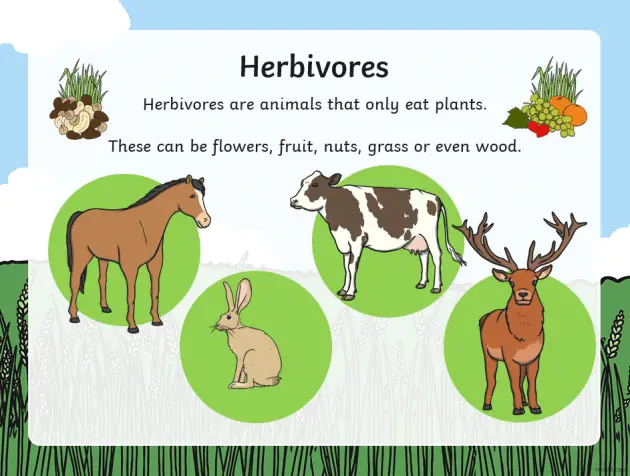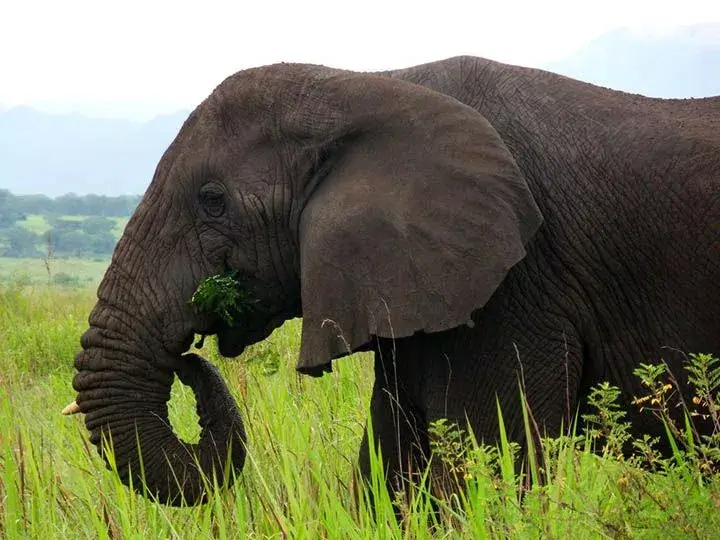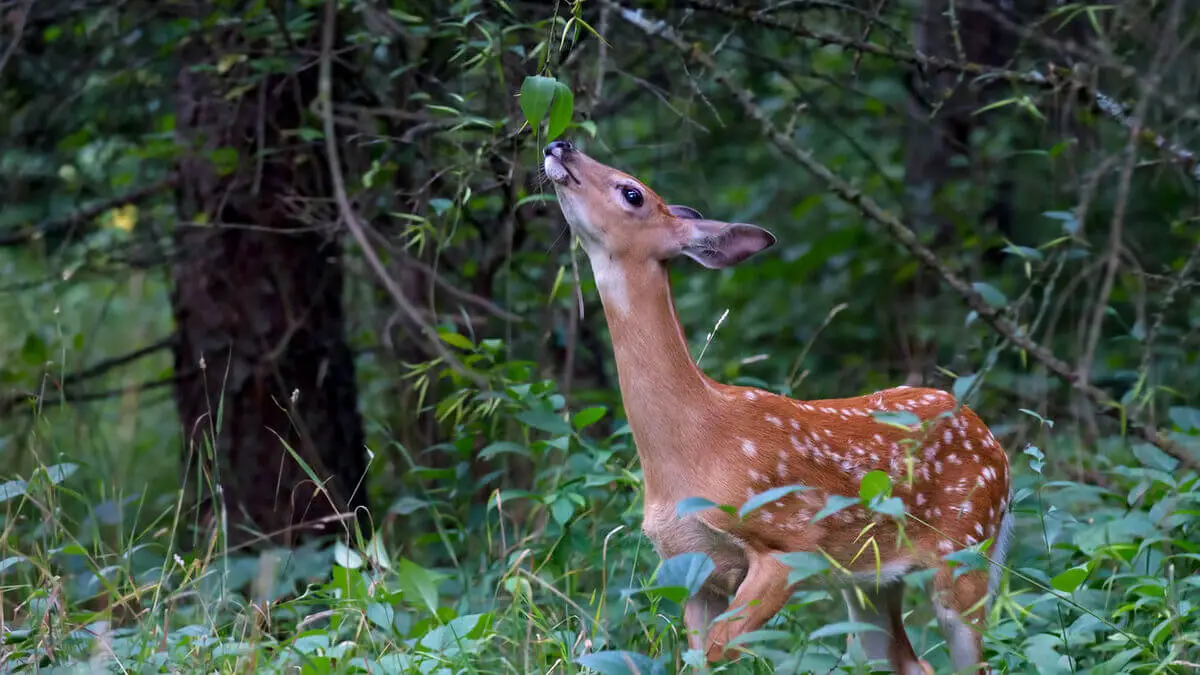Herbivorous animals solely consume plant-based diets, showcasing various adaptations for digestion and foraging. Examples include elephants, giraffes, cows, rabbits, parrots, tortoises, and caterpillars. They play crucial roles in ecosystems through seed dispersal, grazing, and influencing plant community dynamics. Conservation efforts are vital for their survival.
Definition of Herbivores

Herbivores are animals that primarily consume plants as their source of sustenance. This dietary preference distinguishes them from carnivores, which feed on meat, and omnivores, which consume both plants and animals. Herbivores possess specialized anatomical and physiological adaptations to efficiently digest plant matter, extracting essential nutrients for their survival.
These adaptations may include specialized teeth for grinding vegetation, elongated digestive tracts to maximize nutrient absorption, and fermentation chambers to break down cellulose. By relying on plants for energy, herbivores play crucial roles in ecosystems as primary consumers, influencing plant distribution and population dynamics through their feeding habits.
Different types of Herbivores
Herbivores encompass a diverse array of animals, each with unique feeding habits and dietary preferences. Understanding the different types of herbivores provides insight into their ecological roles and adaptations. Below is a concise overview of various categories of herbivores:
| Type of Herbivore | Description |
|---|---|
| Grazers | Grazers predominantly feed on grasses and low-lying vegetation found in open habitats. |
| Browsers | Browsers consume leaves, shoots, and fruits from trees and shrubs, often in wooded environments. |
| Frugivores | Frugivores specialize in consuming fruits, aiding in seed dispersal through their dietary habits. |
| Folivores | Folivores primarily feed on leaves, possessing specialized digestive systems to process foliage. |
| Granivores | Granivores consume seeds and grains, playing crucial roles in seed dispersal and ecosystem dynamics. |
| Nectivores | Nectivores feed on nectar from flowers, contributing to pollination and the reproductive success of plants. |
Characteristics of Animals that Only Eat Plants
Animals exclusively consuming plants exhibit several distinct characteristics:
- Specialized Digestive Systems: Herbivores possess digestive systems optimized for breaking down cellulose found in plant matter. These systems often include large fermentation chambers or multiple stomach compartments to aid in the digestion of tough plant materials.
- Dental Adaptations: Many herbivores have specialized teeth adapted for grinding and chewing fibrous vegetation. These adaptations vary among species but are often tailored to the specific types of plants they consume.
- Efficient Processing: Herbivores are capable of efficiently processing large volumes of vegetation to extract nutrients essential for their survival. They have evolved mechanisms to extract maximum nutrition from plant matter, often requiring them to consume large quantities of vegetation.
- Physical Adaptations: Some herbivores exhibit physical adaptations such as elongated necks, specialized appendages, or prehensile tongues to reach and consume plant material. These adaptations enable them to access vegetation in their environment efficiently.
- Selective Feeding Behavior: Many herbivores exhibit selective feeding behavior, preferring certain types of plants over others. This behavior is often influenced by factors such as nutritional content, availability, and palatability of plant species.
Examples of Animals that Only Eat Plants

When examining animals that exclusively consume plants, many examples stand out for their unique adaptations and ecological roles. Let’s check them out:
A. Elephants:
- Elephants, the largest land animals, are renowned herbivores found in diverse habitats across Africa and Asia.
- Their diet consists primarily of grasses, leaves, bark, and fruits, which they consume in large quantities to sustain their massive size.
- Elephants possess specialized teeth and a versatile trunk, enabling them to extract and consume a wide variety of vegetation.
B. Giraffes:
- Giraffes are renowned for their long necks, which they use to reach tall branches and consume leaves from acacia and other trees.
- Their prehensile tongues and specialized lips allow them to grasp and strip foliage, avoiding thorns and spines.
- Giraffes have a unique digestive system capable of efficiently processing the high-fiber diet of leaves.
C. Pandas:
- Pandas are iconic bamboo specialists, relying almost exclusively on bamboo for sustenance.
- Their digestive system has evolved to efficiently process bamboo, despite its low nutritional value and high fiber content.
- Pandas possess a pseudo-thumb, which aids in grasping bamboo stalks and stripping leaves for consumption.
D. Koalas:
- Koalas are arboreal herbivores native to Australia, feeding primarily on eucalyptus leaves.
- They have specialized digestive adaptations to detoxify the toxins present in eucalyptus leaves, allowing them to safely consume this foliage.
- Koalas have a slow metabolism and spend most of their time resting to conserve energy, as eucalyptus leaves provide low nutritional value.
E. Deer:
- Deer are widespread herbivores found in various ecosystems worldwide, with diets consisting of grasses, leaves, shoots, and fruits.
- They possess specialized teeth for cutting and grinding plant material, as well as a complex digestive system capable of processing diverse vegetation.
- Deer exhibit seasonal dietary shifts, adjusting their feeding habits based on the availability of different plant species.
F. Cows:
- Domestic cattle, including cows, are herbivorous ruminants primarily grazing on grass and other forage plants.
- Their digestive system features a multi-chambered stomach, facilitating the fermentation and breakdown of cellulose-rich plant material.
- Cows are crucial for providing milk and meat to humans, underscoring the significance of herbivores in agriculture.
Conclusion
In conclusion, the examples of herbivorous animals highlight their diverse adaptations and ecological significance. From elephants and giraffes to pandas, koalas, deer, and cows, these herbivores play crucial roles in maintaining ecosystem balance and underscore the importance of conserving their habitats for future generations.
References:
https://nhpbs.org/wild/herbivores.asp
https://www.adc-fl.com/dentist-office/englewood-fl-34223/guide-to-herbivores-ominvores-and-carnivores

I’m Christopher Benjamin, a dedicated Animal Nutritionist at Ethos Veterinary Health with a Bachelor of Science in Animal Science from Michigan State University. My lifelong passion for animals led me to establish AnimalsData.Com. Here, I share expert advice, educational resources, and inspiring stories to empower fellow pet lovers worldwide. Join our community as we celebrate the beauty and diversity of our beloved animal companions!
